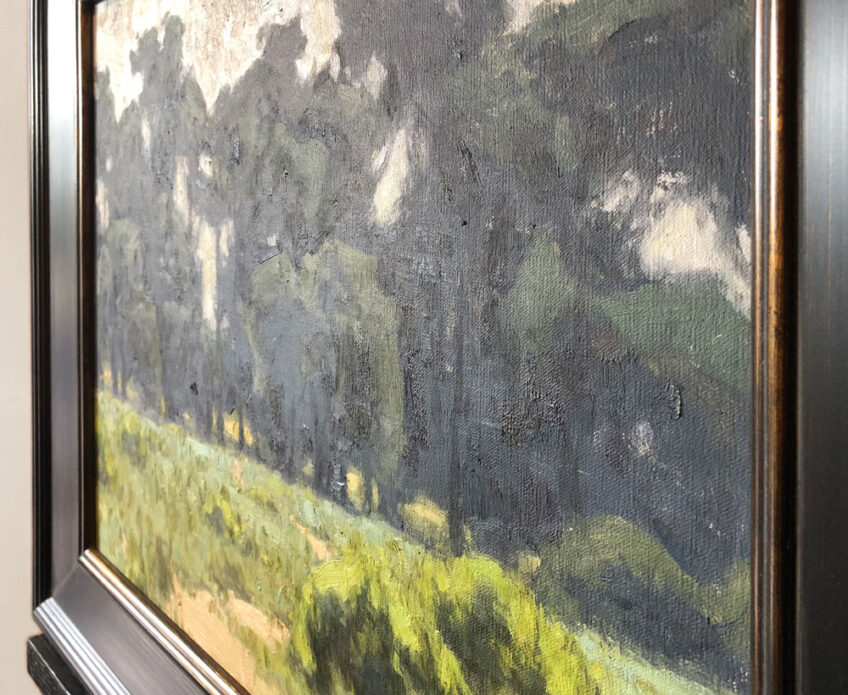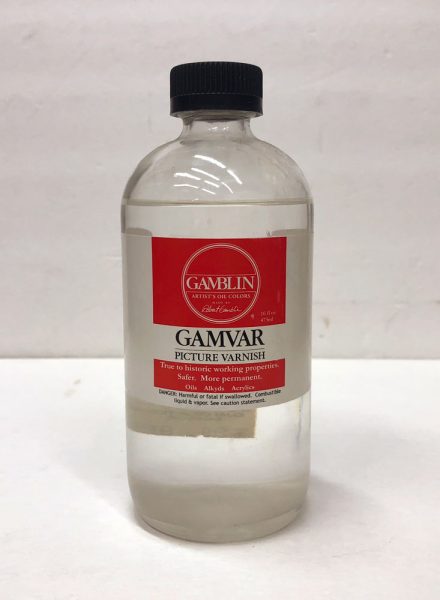I was recently in a friend’s home and noticed a large oil painting on his wall. The surface sheen of the canvas was very uneven. Some areas of the painting were glossy and others were matte. When I asked my friend if he would like some help applying a coat of varnish he told me he assumed the painting was supposed to look like that. It was the perfect time to explain the three reasons to varnish oil paintings.
Three Reasons to Varnish Oil Paintings
- To protect the surface
- To create an even sheen (glossy or matte)
- To revive the saturation of colors that have become dull due to the drying process
#1 is definitely the most important reason to varnish an oil painting. Dust and grime can accumulate on the surface of paintings over time, especially if a painting hangs in a smoky environment. The protective layer of varnish can be removed to restore the painting to its original look. But you have to be sure to use a removable varnish.
The #2 reason is what alerted me that my friend’s painting needed varnish. As an oil painting dries, the surface may not end up with a uniform sheen. Sometimes this is caused by the pigment mixtures themselves and whether any mediums were used. Other times it depends on whether all parts of the painting were allowed to dry at the same rate. Either way, a varnish layer will bring the surface of the painting to an even sheen.
Reason #3 has to do mainly with color. Even if the painting dries to a uniform sheen, sometimes certain colors will end up looking duller than they did when they were wet. You may notice this effect in areas painted with dark earth tones like burnt umber. In artist jargon we might say that the color dried “flat.” A coat of varnish can bring back the saturation of these flat colors.
Recommended Varnish
Now that we know the reasons to varnish, how do we go about choosing a varnish? As I mentioned already, be sure to look for a removable varnish. I think it’s also important to choose a varnish that doesn’t change color. (Widely-used varnishes made from tree resins like dammar can yellow and darken over time. As you might know, I do my best to avoid materials that cause yellowing.)
In the 1990s, Robert Gamblin collaborated with the National Gallery of Art in Washington DC to create a better varnish for artists and conservators. The result is Gamvar Picture Varnish. Gamvar is removable with mineral spirits and Gamblin claims that it will stay water-clear over time. You can even pick your desired sheen with gloss, satin and matte versions available. I’m partial to the matte look myself.
Have something to add about reasons to varnish? Leave a comment below!


27 Responses
Virginia Beale
Thanks Dan! I am always looking for a good matte varnish…. does this one require the painting be at least six months dry before applying? That has been my experience so far with varnishes.
Dan Schultz
According to Gamblin’s website: “Gamvar may be brush applied when the painting is dry to the touch and firm in its thickest areas. For some oil paintings, that may be two weeks, for others, 2 months. To check if it’s dry, gently press your nail into the thickest part of your painting.”
Tina Jalalian
Thank You Dan! Very helpful Info. Cant wait to Varnish my paintings 🙂
Diane
Thanks very helpful. If the painting is 8 years old is it too late to varnish?
Dan Schultz
As far as I know, it would be totally fine to varnish an 8-year-old painting. You might want to gently wipe the surface of the painting first though, to remove any dust, etc.
Liz Todd
Hi Dan,
Any thoughts about using Retouch Varnish ? I often use this when part way through a painting and want to even out the
surface. It also allows me to paint, then wipe out if I don’t like the added touches.
Thanks !
Liz
Dan Schultz
I’ve used retouch varnish in the past, but the kind I used was made with dammar resin which has a tendency to yellow over time. So I have been avoiding it. Plus, I don’t really like having too many layers in a painting because I want to be sure the paint itself can easily bond and not be separated by varnish layers in between. Does that make sense? I bet a web search would lead you to more info about using retouch though. You might be able to find more in-depth advice on it….
Liz Todd
Thank you for the feedback Dan. Interesting to know. So many learning curves. Happy holidays !
Scott Gellatly
Nice article, Dan! Thanks for the shout-out!
Cheers,
Scott
Scott Dienhart
I have always struggled with varnish a crucial step in the success in a painting. I have not had much luck with Gamvar but I have not tried the newly released matte and satin finishes. Anything important that I may be missing on the application process?
Dan Schultz
Hey Scott — good to hear from you. Gamblin has some videos on their site showing the process they recommend. https://gamblincolors.com/oil-painting/gamvar-picture-varnish/
Andy Fulton
Dan, I paint with water based oil. Does varnish work ok with these water based oils?
Dan Schultz
I don’t have much experience with water-mixable oils. You’ll have to do some research and see what you can find out. I’d appreciate a comment here if you do find some good advice on that.
Andy Fulton
Dan, my first step was with a knowledgeable fellow at the San Clemente Art Supply store. He said no don’t varnish my water based oils. But I will look further and let you know. Thanks, Andy
Tricia hillenburg
Does the gamvar varnish work well with walnut oil paints and mediums. I’ve had some painting parts in the past that have had beading (where the varnish avoided certain areas) and I’m not sure what caused it. I don’t remember what I was using at the time. Thanks
Dan Schultz
Hmm I’ve never had problems with Gamvar beading up. I use M. Graham oils (made with walnut oil) all the time. Not sure what might have caused that result for you.
Lee Edwards
I too am partial to Gamvar Matte finish. It seals in the colors but doesn’t cause reflected glare like the glossy. One issue that has come up: when the varnish dries I can see some lap lines where the brush strokes overlapped. Typically I’ll brush back and forth horizontally on the canvas which is flat on a table, using a cheap 2″ nylon brush that can be discarded. I see from the Gamlin demonstration video they recommend a scrubbing type of brush work in multiple directions. One artist has recommended I simply use a soft cloth to apply the varnish without brushing. What do you recommend?
Dan Schultz
I apply the varnish as Gamblin recommends — I use a cheap synthetic brush with a scrubbing motion. I also try to keep from applying the varnish too thickly.
Austin Saunders
I like what you said about varnishing your oil paintings in order to protect the surface. My brother has been telling me about some paintings that he wants to buy soon, and he wants to make sure that they stay in good condition. I’ll share this information with him so that he can look into his options for professionals who can help him with this in the future.
Zachary Tomlinson
Thanks for helping me understand the importance of varnishing oil paintings. I’ve been seeing ads about these lately around town and I wondered why one would opt out to get a painting varnished. The idea of giving painting protection from dust and grime is brilliant! I should share this with my aunt since she has this very old oil painting in one of her houses.
Dinah Rodriguez
Thank you for your help on this subject of varnishing oil paintings! I shall hop to it!
Anna Daugherty
I have an oil base painting with some acrylic paint as well. Can I use the Gumvar matte as well on it?
Thank you for your helpful and insightful information.
Dan Schultz
I’m pretty sure it would work fine, but you might want to contact Gamblin through their website just in case.
carol
Hi Dan, I’m coming to this thread late so hope you receive this. I’m working on a new series that features ribbon-like lines over oil and cold wax. Using the wax does dull the sheen and that’s kind of what I’m going for. To enhance the contrast between shine and no shine, I was thinking of using a small brush to varnish the ribbon lines, creating what I hope might be an interesting effect. If it looks terrible, I can just varnish the entire artwork to get a uniform gleam. Do you think it would look weird or particularly awful to try that? If you think it might work, would you try it with satin or gloss varnish? It’s my understanding that you can use gloss over satin but not satin over gloss because of cloudiness. Is that accurate? Lot’s of questions here and thank you, in advance, for considering them!
Dan Schultz
Hi Carol, I don’t think there would be a problem for you to varnish only the ribbon lines, although I don’t know how noticeable they will be unless the painting is viewed from a specific angle. Give it a try to see what happens. I don’t know the answer to your ‘satin-over-gloss’ question though. If the cloudiness issue is true, then perhaps just go with gloss — seems like you’re going for sheen contrast anyway so might as well go with the most glossy in comparison to your cold wax.
Carol
Thank you so much!!
Bob
It’s truly reassuring to know that varnishing not only wraps a painting in lifelong protection and brings back the way the colors felt when freshly wet, but also beautifully unifies its surface to a gentle, even glow.